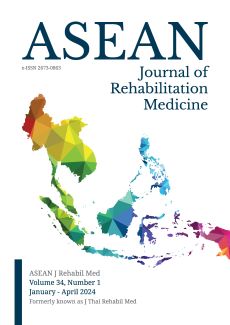Notes from the Editor-in-Chief
Abstract
Over the past few months, our dedicated team of editors and reviewers has been working tirelessly to curate a collection of articles that provide valuable insights and advancements in various fields. We have maintained the highest standards of quality and integrity in the selection process, ensuring that only the most rigorous and innovative research is included in our journal.
Our commitment to facilitating the dissemination of cutting-edge research is unwavering, and we continue to serve as a bridge between the scientific community and the wider public.
In this issue, the first article, conducted by Charussuriyong P., presents the findings of a randomized controlled trial that assessed the effectiveness of anodal transcranial direct current stimulation in improving language ability in patients with post-stroke aphasia. The study revealed no statistically significant difference between the two groups, both immediately after treatment and at the one-month follow-up.
The second article, conducted by Panompornpanich A. and her team, reports on a randomized controlled trial that evaluated the efficacy of rhythmic auditory stimulation on balance in children with cerebral palsy from Sri-Sangwan School in Bangkok, Thailand. The study concludes that the addition of rhythmic auditory stimulation to physical therapy may not improve the efficacy of training beyond the effects of physical therapy alone.
The third article featured in this issue is a prospective cohort study conducted by Salinpramote B and her colleague. The study aimed to evaluate the effectiveness of home-based rehabilitation programs on the functional outcomes of patients with traumatic spinal cord injuries during the post-acute phase. Additionally, the researchers analyzed factors associated with improved functional outcomes.
Moving on, we have a prospective cohort study by Chadchavalpanichaya N and her colleague. The objective of their study was to explore the effectiveness of an adjustable splint in patients with hallux valgus. The findings revealed that wearing an adjustable splint for 12 months in patients with moderate to severe degrees of hallux valgus resulted in a decrease in hallux valgus angle and alleviation of hallux pain, without any serious complications.
The next manuscript in this issue is conducted by Kotcharoen R and her colleague. Their objective was to identify the factors that contribute to cardiac rehabilitation uptake among patients with coronary artery disease in Thailand. The study concluded that while the existing hospital-based cardiac rehabilitation programs in Thailand are suitable for urban patients with coronary artery disease, they may be less effective for those residing in rural areas. The authors suggested that improvements should be made to the existing programs or the develop-ment of more nuanced approaches specifically tailored for rural patients.
The final manuscript in this issue is conducted by Boonsiripipat P and her colleague. Their study involved a retrospective chart review of a university hospital, aiming to determine the demographic and clinical characteristics of patients with primary knee osteoarthritis. The findings revealed that the main characteristics of knee osteoarthritis patients in this study included obesity, advanced age, female gender, civil servant medical coverage, bilateral knee pain, and mild radiographic severity. Notably, patients with a higher body mass index (BMI) were significantly more likely to receive weight reduction advice.
We hope you find this study insightful and informative. Thank you for your continued support and interest in our journal.
Downloads
Published
How to Cite
Issue
Section
License

This work is licensed under a Creative Commons Attribution-NonCommercial-NoDerivatives 4.0 International License.






